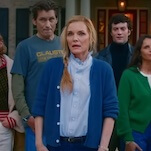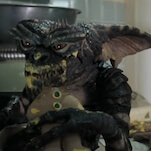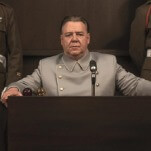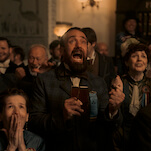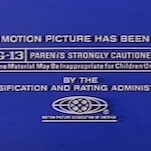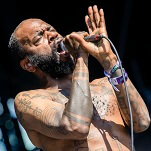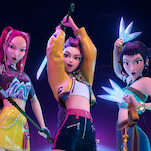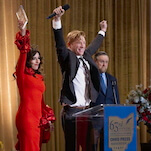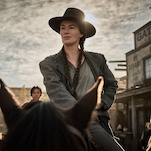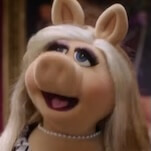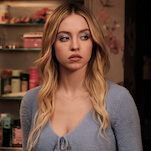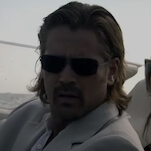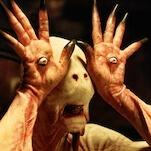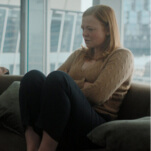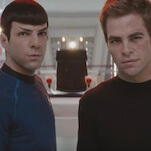Many early comic-book artists stumbled into the profession, and thus expressed some embarrassment over what they did for a living. Not Jerry Robinson. As described in N.C. Christopher Couch’s richly illustrated biography Jerry Robinson: Ambassador Of Comics (Abrams), Robinson was a 17-year-old Columbia University freshman when Batman creator Bob Kane invited him to help out with the Caped Crusader. A self-taught artist and an enthusiastic kid, Robinson relished sitting around with Kane and Bill Finger, cooking up Batman plots. Many people credit Robinson with creating Robin and The Joker—or at least playing a significant role in their creation—and his mixture of the heroic and the bizarre helped define the tone of the original Batman era. Ambassador Of Comics goes on to cover Robinson’s post-Batman career, which involved crime comics, romance comics, war comics, comic strips, Playbill illustrations, political cartoons, photography, painting, and several books about the history and craft of his favorite medium. Couch provides plenty of examples of Robinson’s work, which from his early days to now display a gift for making even ordinary things look playful and eye-catching. The book is occasionally too boosterish, but that’s to be expected, given the subject… B+ (The Joker and Robin copyright © 2010 DC Comics. All rights reserved. Reprinted with permission.)
Originally serialized in the Guardian in the UK, The Night Bookmobile (Abrams) has been collected in a lovely-yet-slight hardcover edition. Written and drawn by The Time Traveler’s Wife author Audrey Niffenegger, and based on her original short story, it’s a love letter to bibliophilia: After fighting with her boyfriend, a young woman comes across a mysterious truck containing every book she’s ever read. Niffenegger’s simple but effective illustrations and clever layouts help create the sense of mood and mystery the story requires, and it’s a skillful piece of storytelling that benefits from its brevity, avoiding the bloat that sometimes troubles her novels. Twenty bucks for 40 pages is a high price to pay, but Niffenegger packs more punch into each page than most graphic storytellers… B+
Another graphic artist moving into the graphic-novel world, Jen Wang gives her debut book Koko Be Good (First Second) a loose, breezy dynamism and a professional sleekness that remains winning even when her characters and story don’t fully measure up. The titular protagonist, Koko, is a flighty, energetic young woman with outsized ideas of what she wants to do with her life. When she meets mild-mannered Jon, who’s more certain about his future—even though that future may not be the right one for him—she’s inspired to try on “goodness” as her latest project, and she recklessly launches into a wave of volunteerism and selling off her worldly possessions to fund the poor. This could be a standard Manic Pixie Dream Girl story, with Koko’s wildness hauling Jon out of his plodding complacency, but Wang brings in a third element that enriches the story considerably: Koko’s friend Faron, a sullen boy with a complicated home life and a secret love of Broadway musicals. And it helps that Jon is as much an influence on Koko as vice versa. Koko Be Good never fully coheres into a directed story; it’s a little shapeless, as the characters bounce off each other and head in no particular directions. But it serves as a sweet slice of life that alternates manic and solemn moments, with beautifully characterized leads making their inner lives felt on their expressive faces. And the book’s energy and verve are terrific. As a debut, this is a striking accomplishment, and a promise of great things to come… A-
On the fifth anniversary of Hurricane Katrina, it’s both heartening and dismaying to look back: New Orleans has made a strong comeback from the disaster, for the most part, but very little has been done to address the issues that brought about this largely man-made catastrophe. In his book, A.D.: New Orleans After The Deluge (Pantheon)—written soon after the disaster, expanded on over the next several years, and now released in a complete softcover edition—Josh Neufeld largely avoids finger-pointing, choosing instead to focus on the highly personal narratives of six Katrina survivors who shared their stories with him. It’s an effective, moving, and never polemic approach, and while Neufeld’s art often recalls Joe Sacco’s, his innovative use of color and lighting cues to indicate narrative shifts raises it to a higher level of sophistication than simple journalism. It’s an excellent piece of work, as timely as it was when it was first written… A-
Blake Bell’s Strange And Stranger: The World Of Steve Ditko set the recent standard for how to put together a coffee-table book about a legendary comics artist, and Bell takes on another innovator of the medium with Fire & Water: Bill Everett, The Sub-Mariner, And The Birth Of Marvel Comics (Fantagraphics). Everett created countless short-lived or one-off heroes for scattered outlets during the post-Superman superhero boom before selling the first Namor The Sub-Mariner story to publisher Martin Goodman, who ran it in Marvel Comics #1 in 1939. Everett’s association with Goodman’s company continued off and on over the decades that followed, although by the ’60s—when Marvel Comics was at its creative peak—Everett struggled with alcoholism and was mostly relegated to inking jobs, even though he helped create one of Marvel’s enduring heroes, Daredevil. Because Everett didn’t have as long or as consistent a career as Ditko, Bell doesn’t subject Everett’s work to the keen analysis he brought to Strange And Stranger. But he makes up for the diminished insight with page after page of Everett’s vivid, varied work, showing how it all emanated from a man who was a lot like his most famous creation: a destructive antihero, always a little angry at the puny humans around him… B
Namor remains a pretty peevish character all these decades later, as evidenced most recently in the first issue of his new ongoing title Namor: The First Mutant (Marvel). And he has plenty to be peevish about, too. Atlantis is in ruins. The surface-dwellers remain a source of frustration. Oh yeah, and then there are all those underwater vampires to deal with. Writer Stuart Moore doesn’t waste much time establishing the plot, which finds Namor teaming up with some reluctant allies to fight the finned bloodsuckers known as “aqueos.” And while so far, there doesn’t seem to be much going on beyond that confrontation—or much of a motive for it—Ariel Olivetti realizes it with smooth, fantastic art that captures the full pulpiness of the undersea drama… B
Artist Eric Drooker, best known for his politically charged street art and New Yorker covers, worked with Allen Ginsberg late in the poet’s career and lent his art to the illustrated portions of the new movie Howl, which dramatizes the events leading up to and fanning out of the creation of Ginsberg’s breakthrough poem. His art works well within the context of the film, but less well within the covers of Howl: A Graphic Novel (Harper Perennial). The subtitle is misleading: This isn’t an original interpretation of “Howl”—which is a poem, not a novel—but a collection of adequately rendered screen-captures of the film’s animation, laid out without much regard to flow, and often hindered by images spread over two pages and split by the fold. Ginsberg’s poem loses its rhythm when broken down line-by-line and interrupted by a lot of page-turning. Read the poem. See the movie. Skip this book… C
The Amazing Screw-On Head And Other Curious Objects (Dark Horse), a collection of shorts by Mike Mignola, is undeniably slight. It’s also undeniably delightful, and that slightness is part of the reason why. Two of the stories in the book—the titular tale and “The Magician And The Snake” (co-written by Mignola’s 7-year-old daughter, Katie)—won Eisner Awards, and it’s easy to see why. The tales of Hellboy and the B.P.R.D. have always had an element of silliness; Mignola is one of today’s few writers with an ability to mimic the random dream-logic of the best fairy tales. In Screw-On Head, he throws out any pretense of seriousness and embraces the weird. Characters with names like Emperor Zombie wander in and out of frame and struggle for control of ridiculous arcane artifacts, make deals with devils, or embrace unusual friendships in the face of inescapable mortality. What starts off as a sort of self-parody becomes as curiously affecting as the best Hellboy stories, with Mignola’s elegantly eerie art providing the context for his weightless flights of fancy… A-
Also undeniably slight: The collected Dr. Horrible And Other Horrible Stories (Dark Horse), which puts 2009’s one-shot comic about Joss Whedon’s tragic supervillain together with three online comics from MySpace Dark Horse Presents and one new story about the Evil League Of Evil. Whedon’s three-part online musical miniseries, starring Neil Patrick Harris as the titular bad guy, introduced a barely fleshed-out, potentially interesting larger world full of cut-rate heroes and villains. But the stories here don’t expand on it so much as they provide minor riffs on existing characters: There’s a short origin story for Moist, a goofy look inside Captain Hammer’s head, a brief Dr. Horrible adventure, and a closer look at Penny’s innate goodness that seems almost in poor taste, considering where the miniseries took her. Zack Whedon’s Evil League Of Evil story is enjoyable, though, with its Ben Edlund-esque look at a bunch of villains with fairly narrow skills, comically outsized egos, and only marginal competence. The whole package is just a mild diversion for fans of the web series, but when have Whedon’s fans ever been mild about anything? They might well love this… B-
The hardback collection of the first three issues of Archaia’s Fraggle Rock comics revival is also something of a project for existing fans; it re-introduces the world of Jim Henson’s puppet series Fraggle Rock, for a new generation, but its images—by a variety of artists, in a variety of styles from photorealistic to cartoony to expressionistic—never have the dynamism of real Muppets. Still, the stories fit neatly into Henson’s world, with their smartly executed, cleverly framed metaphors about environmentalism, community awareness and responsibility, and generally just being a good friend and neighbor. The original show launched in 1983, so it’s entirely possible that former fans might want to pick up this book to read to their own young kids; the bright colors and memorable characters remain a good hook for the younger set, while older readers may be surprised at how intelligent the messages are, without sacrificing gentle humor and a sense of eager play… B+
The collection AX: Alternative Manga, Vol. One (Top Shelf) distills a decade’s worth of product from Japan’s leading outlet for experimental comics into 400 wildly eclectic pages. They run the gamut from conventionally rendered but intensely personal tales of love and crime to deeply surreal, disturbing abstractions. Like Mome, Kramer’s Ergot, or similar Western alt-comics anthologies, AX is naggingly inconsistent, even when culled for this best-of. Too much of the work here is more noteworthy for its rawness than its visionary qualities, or its comprehensibility. Still, AX is valuable for its historical and cultural context, and for the scattered stories—like Katsuo Kawai’s poetic “Push Pin Woman” and Shinya Komatsu’s fanciful “Mushroom Garden”—that bull through the murk… B
By contrast, few comics fans should have difficulty getting into A Drunken Dream And Other Stories (Fantagraphics), a collection of work by Moto Hagio, one of the women who pioneered a more down-to-Earth, realistic style of shōjo—manga aimed at Japanese girls. Ironically, Hagio’s deepest love is far-out science fiction, even though the samples of her more fantastical work in A Drunken Dream—like the title story, about a tragic romance that persists across time and space—focus more on the characters’ reactions to the supernatural than on filling pages with imaginative imagery. The stories in A Drunken Dream range from weird, powerful allegories (like “Iguana Girl,” about a child who grows up thinking of herself as a hideous reptile after her mother rejects her) to dreamy tales of love and loss (like “Marié, Ten Years Later,” about the tumultuous relationship between a professor and one of his students). But the best pieces here focus on memories of childhood, of playmates treated cruelly or parents and children misunderstanding each other. Sometimes the dialogue is too blunt or the stories too heavy-handed, but Hagio frequently uses her final pages to leap from the prosaic to the profound, striving for a transcendent emotional effect. And she nearly always achieves it. Few stories in the entire history of the medium have been more overwhelming than “Hanshin: Half-God,” a tale of conjoined twins—one haggard, one gorgeous—and their spiteful, symbiotic relationship. It’s a potent metaphor rendered with the intensity of an EC comic… A-
In the late ’40s, Flash Gordon was a huge pop-culture icon who appeared in features, shorts, daily and Sunday stripes, pulps, and radio shows—and, as can be seen in Flash Gordon Comic Book Archives, Volume 1 (Dark Horse), an ongoing comic. The stories themselves (most of which originally appeared in Four Color Comics during the post-war years) are pure kiddie pulp, not much to speak of, but there’s some handsome art by Paul Norris and Frank Thorne that predicts much of the ’50s science-fiction futurism that appeared in its wake. This new Archives also shows off some beautiful cover-art reproductions and original text inserts about astronomy and rocket science, and it’s a fun read for anyone interested in the early days of space-age mania… B-
As justifiably beloved as Peanuts creator Charles M. Schulz has remained over time, it’s no secret that his work suffered a marked decline in later years. With the strip’s massive popularity came pressure to produce all sorts of peripheral material, and by the late ’70s, Peanuts had lost much of the sophisticated juxtapositions and bittersweet tone of its early days. That’s the period covered by The Complete Peanuts, Vol. 14: 1977 To 1978 (Fantagraphics), and the book shows just how much Schulz was all over the map during that time. Dozens of new characters are introduced, most of them smacking of some level of gimmickry, and the gags misfire as often as not. This is still a worthwhile volume of Complete Peanuts, though; it has a charming introduction by Alec Baldwin, the usual top-quality production of the whole Fantagraphics reprint library, and some fun story arcs, including one where Charlie Brown takes a bite out of the hated Kite-Eating Tree, which gets him in trouble with the Environmental Protection Agency. But this one is more or less for series completists who were going to buy it anyway… B-
Only a brain incubated in the warm, nourishing goo of Looney Tunes and vintage Disney cartoons could have produced Sammy The Mouse. The third issue of the gorgeously produced, sporadically released series in Fantagraphics’ Ignatz Collection is written and drawn by Zak Sally, creator of 2009’s stunningly naked graphic novel Like A Dog. (He’s also the former bassist of the indie-rock band Low.) Issue #3 sees the misanthropic Sammy, still reeling from last issue’s blind date (which was apparently set up by either God or the author himself), simply trying to muster the gumption to leave his house. Once that Herculean task is accomplished, he winds up scouring Sally’s grim, lurid, bruise-colored world looking for his friend Puppy Boy—only to find a treasure map and more trouble than a hungover homebody like Sammy can handle. As always, Sally’s use of silent panels and dynamic perspectives guide readers’ eyes toward nightmarish horizons and grotesque situations, including a hangout called the Baby Bar—a bone-littered saloon carved out of the preserved corpse of a giant infant—and disturbing cameos from an unidentified mouse, a talking fish in a bowl, and a little bald guy. (These characters might draw the attention of the estates of George Herriman, Theodor Geisel, and Charles M. Schulz, respectively.) A grimy, metaphysical malaise drips from every line of Sally’s lush yet unwholesome artwork, especially when he’s plundering the iconography of innocence and youth in the service of disorienting discomfort… A-
It’s immediately obvious that Alan Martin recycled his own Looney Tunes-like bullet-reversal routine from Dirty Helmets for Tank Girl: Hairy Heroes (Image), so it’s going to look even lazier when all three Rufus Dayglo-drawn one-shots arrive side by side in one raggedy, predictably anarchic volume, the upcoming We Hate Tank Girl. Fortunately, Hairy Heroes as a whole is easily the best of the three, following up on the most promising narrative strands of its predecessors, Dark Nuggets and Dirty Helmets—for instance, Booga’s mail-order addiction (which probably explains the team’s mountainous piles of accumulated kitsch) and the Incredibles-esque gem “The Young Tank Girl: Mission 3098401583.” The story veers into fan-service territory with its multitudinous TG iterations, but it never lets up on the frothy, filthy fun—that is, until the last two pages, when the whole thing, surprise, surprise, stops on a dime… B
Updating Bob Kanigher and Joe Kubert’s classic Haunted Tank series to the modern day involves all sorts of thorny issues. In Haunted Tank (Vertigo)—a collection of 2008’s five-issue miniseries—writer Frank Marraffino redeploys the original series’ Civil War-meets-World War II action to the Iraq War, and throws caution to the wind by making his new tank commander an African-American; this leads to a powerful scene when the ghost of Confederate General Stuart makes his first appearance, though later in the series, that tension devolves into petty bitching. Still, it’s an audacious concept, and Henry Flint’s art is exceptional. Elsewhere on the front lines, Our Army At War (DC) revives the title that was once home to Kubert’s Sgt. Rock and Easy Company for a one-shot story contrasting the wartime adventures of two soldiers, one in World War II and one in modern-day Afghanistan. The comparison of the two wars is inherently fatuous and sometimes comes across awkwardly in the telling, but author Mike Marts hits a few powerful emotional buttons, while Victor Ibáñez delivers some really striking art… Haunted Tank: B-; Our Army At War: B
Writer Macon Blair and artist Joe Flood live in Brooklyn, which amounts to more than just an authorial footnote in the context of Hellcity: The Whole Damn Thing (Image). The duo has scooped up all the scummiest parts of city life—noxious roommates, train-car panhandlers, the ever-present sights and smells of urban decay—and ladled them onto a crime noir set in hell, producing a darkly comic vision that’s supernatural in one panel and super-mundane the next. Bill Tankerslee wasn’t a good man in life, but he was a good detective, and now that Lou (as in Lucifer) has gone off the deep end and begun shirking his demonic responsibilities, some higher-ups have given the damned gumshoe an opportunity to get back in the game. He’s even been allowed a pass on the weekly torture sessions that require him to watch his wife’s murder and his own suicide on loop. Boutique label Gigantic published the first volume of Hellcity, but the second and third almost never saw the light of day, which would have been a shame. Even if the story never fully reproduces the sly wit and well-observed gags of its first few dozen pages (which recall a bleaker, bloodier Ugly Americans), it gets pretty good mileage out of its bummer of a premise—that is, that hell is never farther away than the nearest big city. B-



















